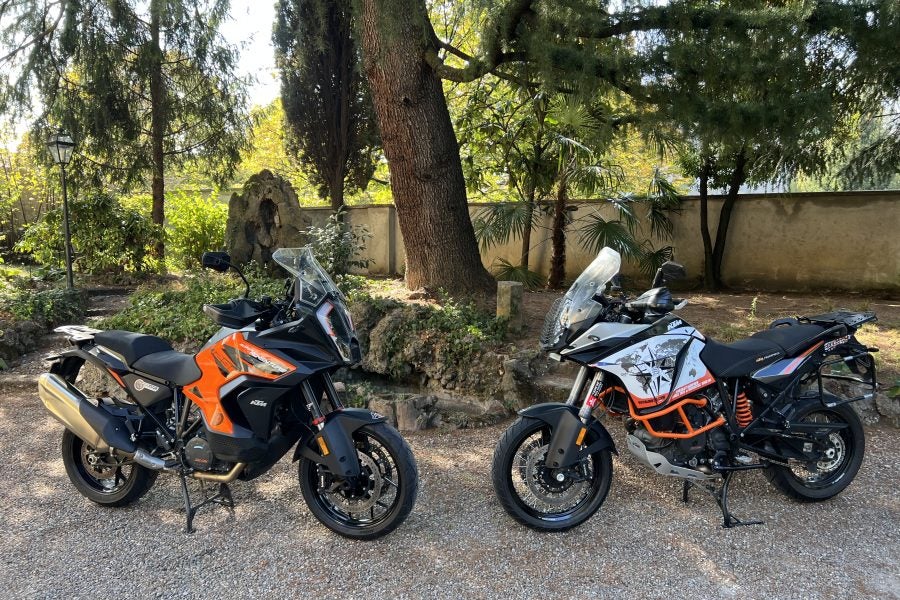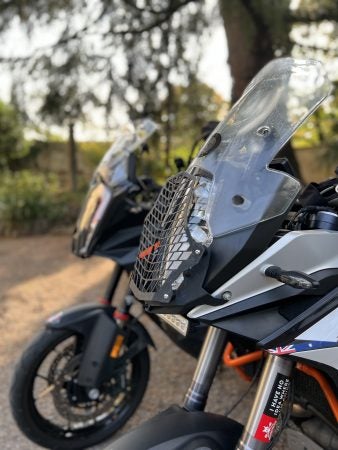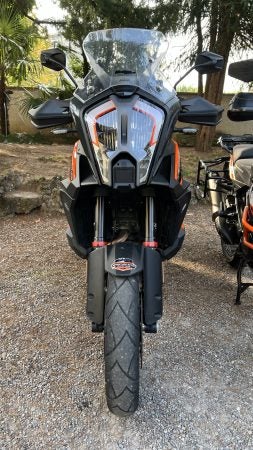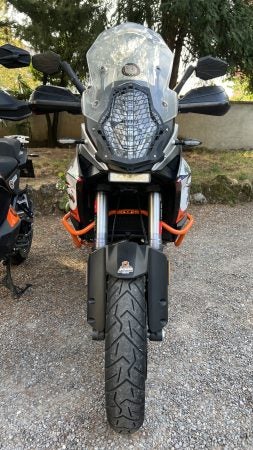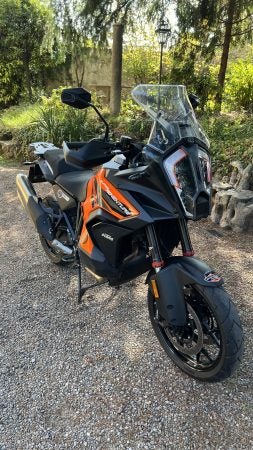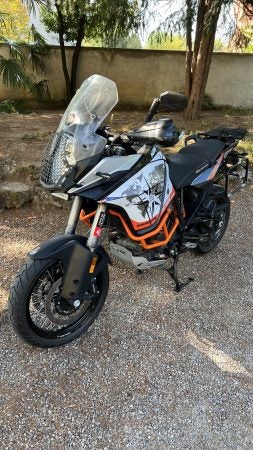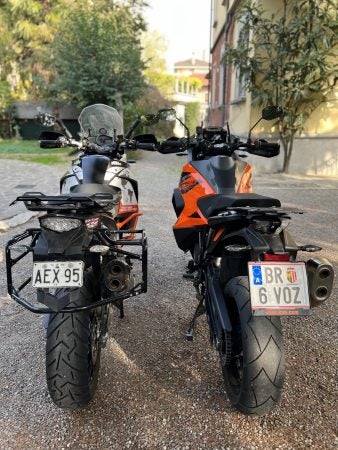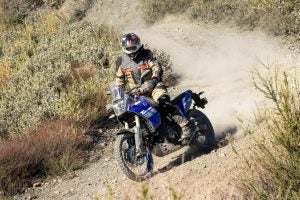I’ve put down a lot of miles on KTM’s twin-cylinder machines. My first orange love was the 1190 Adventure; then, over the past two years, I got used to the light weight and maneuverability of the smaller KTM 890 Adventure, with a lower tank and new lightweight engine.
That experience left me with some bias. When I first laid eyes on the 1290 Super Adventure S, I thought it was just too much of a bike for me to handle through tough off-road work—but I was signed up to ride it in the KTM Adventure Rally in France. Might as well make the best of it! I decided to compare this new beast to my old 1190, asking myself the question: If I had the opportunity, would it be worth it to sell my 1190 and get this new 1290?
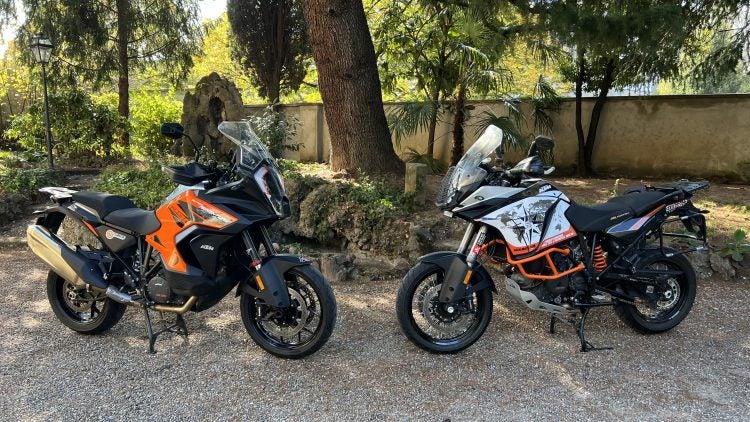
KTM 1290 Super Adventure S 2022 Vs 1190 Adventure 2013. Photo: Paolo
Here’s what I found out. Bear in mind that I rode over 200,000 km (127,000 mi) on Bronte, my KTM 1190, over five years, so there’s little I do not know about this bike. I also had the chance to try the previous 2018-edition 1290 Super Adventure S. I felt like that motorcycle wasn’t as much of an upgrade over my old 1190. It had a bit more power, but it wasn’t noticeably different—just a different headlight and some more refined electronics. I preferred my 1190 in every possible way.
But this new 1290 is much further evolved, with design more along the lines of the 790/890 series. There’s a lower center of gravity, and the fuel tank is wrapped around the engine, just like the parallel twin series. Are the changes enough to make it worth upgrading from my old 1190?
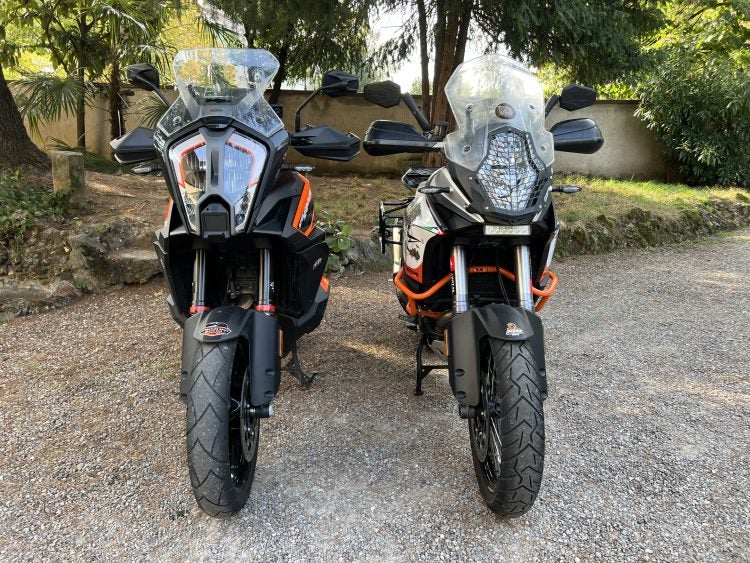
The two bikes side to side look completely redesigned. Photo: Paolo
Design
The KTM 1290 is a big bike, but despite its size, it’s more maneuverable than its predecessors. Compared to the older models, this bike looks bigger in the eyes of the onboard riders but it actually handles much better. The riding position is a couple of centimeters lower, and it’s more comfortable to ride while seated. The adjustable standard windshield provides better protection from the wind. The new windshield shape also provides better shelter from elements than my 1190. On that bike, I needed an accessory touring windshield for the same protection from the elements.
- Photo: Paolo
- Photo: Paolo
- Photo: Paolo
The new 1290 is much cooler than the older 1190 and 1290 models—literally. Those bikes had a lot of excessive heat buildup under the seat, but now KTM has fixed the problem. Now, two separate radiators blow that hot air out to the side of the machine, right in front of your knee, instead of seeing it accumulate beneath the seat. The engine has also been rotated forward a few degrees, shifting the rear cylinder head away from underneath the rider, which also helps keep things cool.
The 1290 Super Adventure S has also been redesigned to be more street-oriented than its predecessors. The swingarm is slightly longer and the rider sits in a more aerodynamic position for better tackling the tarmac at higher speeds.
Weight-wise, my old 1190 was 217 kg dry; while this one looks bigger and bulkier, it’s only 220 kg. There’s not much difference between the two, despite the different look.
- Photo: Paolo
- Photo: Paolo
Engine
The 1290 is powered by a 1301cc V-twin that produces a whopping 160 horsepower and 103 lb-ft of torque. That might sound like a lot, but today’s technology allows even the most inexperienced riders to handle this monster. You might think my old bike Bronte, which was powered by the same LC8 design with 1190 cc capacity, isn’t too different from this new one. However, the torque is delivered very differently, thanks to the completely redesigned ECU.
KTM 1190 Adventure: 92.2 lb-ft/124.8 Nm @ 7500 rpm
KTM 1290 Super Adventure S: 101.7 lb-ft/138 Nm @ 6500 rpm
So, even if the new 1290 is a bigger and more powerful motorcycle, it’s also more manageable in terms of power and delivery—similar to its “German cousin” (the BMW GS1250 delivers 143 Nm @ 6250 rpm)
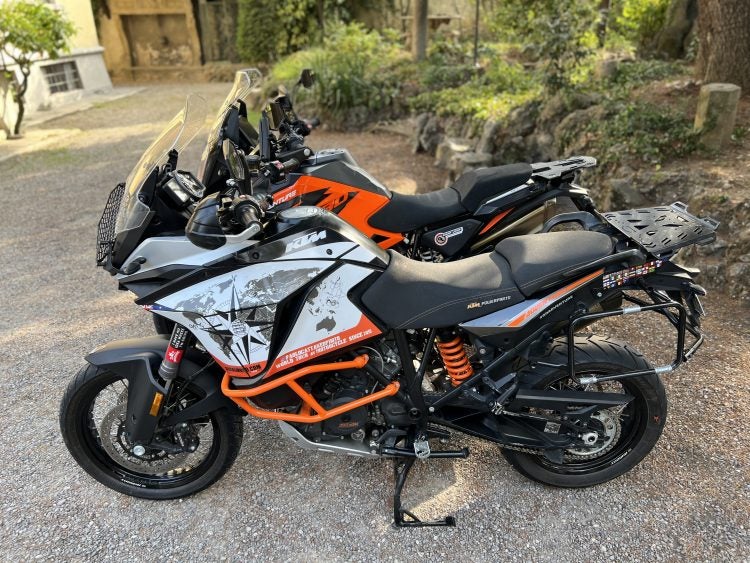
Photo: Paolo
The 1290 SAS has five riding modes to choose from: Street, Sport, Rain, Offroad, and the scary Rally mode. The 1190 had only four, Street, Sport, Offroad and Rain.
The best development is this new Offroad mode, which I tested extensively during the four days of the KTM Adventure Rally in France. The scary machine became completely manageable and responsive, allowing full control in rough conditions. Some might say Rally mode was more appropriate for the situation, but I tried and it was too powerful for the tight and narrow French trails.
I used Rally mode all the time on my 890 Adventure, but I couldn’t on the new 1290. I found it easier to be completely safe and enjoy myself in Offroad mode without worrying too much about the furious throttle response. Rally mode is simply… raw. It requires advanced riding skills to be used offroad, but it’s quite fun on the tarmac. Rally mode has also four different settings of throttle response: Street, Sport, Offroad, and Rally, similar to the 890 Adventure, but the issue here is that it’s using the “full unmanaged” power of the machine, which can be overwhelming for some riders.
Once the Rally mode is engaged, the whole display layout changes, and… it’s on! No more fuel gauge, no more “useless info” occupying important parts of the dash. Just the bare minimum and large icons for things that matter (like gears and slip control level). Slip control is very handy feature, allowing the rider to regulate how much the rear wheel spins. The traction you want on a soft sandy beach is not the same as you would want on a rocky uphill, or a gravel road, or a muddy section.
If you’re never been in those situations, this could create confusion, as you may not know what to select—but that’s where Offroad mode and the traction control On/Off settings come in handy. Again, this is another improvement over my old 1190, which only had the choice of MTC On or Off and and an offroad riding mode.
- Photo: Paolo
- Photo: Paolo
- Photo: Paolo
Suspensions
In my opinion, suspension is the most impressive feature of this motorcycle. The WP Apex electronic suspension is the absolute star of the show, even more than the upgraded looks, electronic gadgetry and engine capability. The first difference that I noticed was that fork and shock can be adjusted on the fly, without stopping the bike. On the old 1190, I had to stop the bike and change the preload while the bike was still. Also, the three different shock settings (Street, Sport, and Comfort) weren’t that different from one another.
Now, front and rear suspension can be adjusted in height and stiffness to the mm. There are several pre-set preload settings available, and (too) many settings to regulate your shocks, in case you prefer them hard, soft, or somewhere in between those.
There’s also the new semi-autonomous “Automatic” setting. This mode allows the shocks to self-regulate themselves, matching the surface you’re riding on. The Offroad mode also adjusts the shocks to suit the terrain when it’s super-bumpy and irregular. Ruts, holes, jumps, bumps, and washboards are not a problem anymore. Even on the tarmac, I’ve been using this setup a lot since it’s the most comfortable on paved roads here at home in Italy.
It’s not just electro-trickery; the hardware itself is well-suited to the job. The WP Apex suspension is brilliant in absorbing all the impacts a 250 kg bike faces on a hard enduro day, but also fantastic when you turn back onto pavement and want responsiveness or comfort on the street.
I threw this bike down steep downhills at over 90 km/h and hit massive ditches, where I thought my front wheel or forks would bend in a half from the impact… but instead, the bike went over it like it was a normal speed bump on a city road. Incredible. The fork and shock, and the electronics behind them, are miles ahead of the comparatively crude WP suspension I had on my 1190. That suspension served me well, but it didn’t have the same level of AI control; it just had an electronic preload.
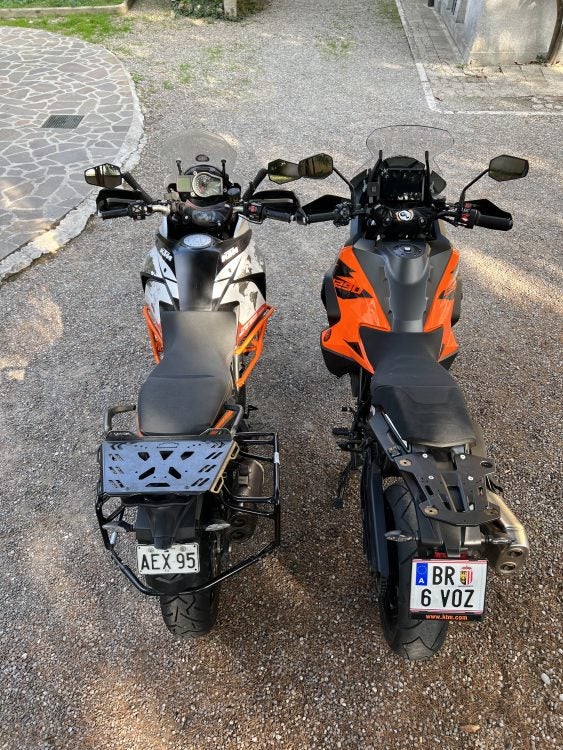
Size wise, they are quite similar, despite the plastics on the 1290 SAS being a bit bulkier. Photo: Paolo
Brakes
If the suspension is the star of the show, brakes are a close second. The 1190 was one of the first bikes in the world with Bosh 9H cornering ABS; 10 years ago that feature seemed like something from sci-fi movies. Nowadays, ABS is mandatory on almost all bikes in the EU, and it’s evolved into a thing of beauty. You can can mash on the brake lever at any speed and the bike will not lose its grip. My 1190 had a great braking system, but the 1290 SAS Bosh 10.3 ME (with cornering and offroad anti-lock braking modes) is far more advanced, and now you can brake with one finger.
I used to have always two fingers on my front brake in the city, or when riding hard on the open road, but that’s not necessary on the 1290; it requires almost no effort to decelerate.

The bike handles like a smaller machine, thanks to the lower center of gravity and electronic suspensions. Photo: Paolo
Ride and Handling
The KTM 1290’s handling surprised me. It’s quite nimble and easy to maneuver, considering the bike’s size..
The new design with the lower gas tank, developed from the 790/890 series, makes it easier to push a big machine through its paces. I loved switching from my 1190 to my 890, since the new bike was far more agile and maneuverable, even though the new bike was only 15 kg lighter. But the difference in feeling and the handling was almost uncomparable.
I remember the first day I hopped back on my 1190, after riding with the 890 for over 35,000 km, I wondered how I managed to ride the bigger bike around the world. Now, the 1290 is certainly heavier than the 890, but the maneuverability is similar. Handling is effortless; the only substantial difference is that it’s slightly harder to stop the 1290 while riding off-road, because of the extra weight. But on tarmac, the brakes and suspension are so good that it’s actually easier to ride the 1290 than the 890 or the 1190.
The Extra Pack
One of the most impressive features of the new 1290 SAS is certainly the radar or so-called “Adaptive Cruise Control”. The old 1190 didn’t even had a cruise control so, in this sense we cannot argue that we already have a winner.
The way the radar works is very much similar to the one available on some of the most recent cars. It “scans” the road in front of you and accelerates and brakes by itself according to traffic.
Obviously it doesn’t steer by itself, but it does alleviate a great deal the burdens of long riding days in traffic.
As an engineer, I was utterly amazed to find this kind of tech on motorcycles, considering the bigger complexity of variables that managing a bikes entails compared to cars.
The system works brilliantly, assessing traffic conditions and detecting object (pedestrians, bycicles, cars, etc) even 100m straight ahead of the rider.
I tried to use it at night and it works almost as well as during the day.
Simply brilliant. Nothing better than knowing that the bike will assist you when you get a bit lazy or tired.
Everybody knows that losing concentration, even for a split second, on a motorcycle could cause an accident.
KTM AAC is a thing of beauty and I ended up using it a lot, even al low speeds, cruising into town.
Conclusion
I’m impressed with the KTM 1290 Super Adventure S. It’s a big bike with lots of power, but it’s also surprisingly maneuverable and easy to control. If you were thinking about changing the 1190 for a newer model, the 1290 Super Adventure S is the one to get.
I would recommend giving the 1290 SAS a test ride first, but at the end of the KTM Adventure Rally, I felt like it was an amazing upgrade over my previous bike. You might be surprised at how much you like it, despite how nostalgic are you about the old electronicless LC8 bikes.


